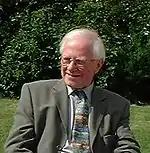Hal Dixon (biochemist)
Henry Berkeley Franks Dixon D.Sc. (16 May 1928 – 30 July 2008) was an Irish biochemist and Life Fellow of King's College Cambridge.[1][2] Born in Dublin, the youngest son of Henry Horatio Dixon, he was interested in science from a young age; his discovery of an optical illusion arising from binocular vision was described by his father in Nature Magazine[3] when he was only nine years old.[1]
Hal Dixon | |
|---|---|
 Hal Dixon | |
| Born | 16 May 1928 |
| Died | 30 July 2008 (aged 80) |
| Alma mater | University of Cambridge |
| Scientific career | |
| Institutions | University of Cambridge |
| Doctoral advisor | Frank Young |
After education at Shrewsbury School he was awarded a scholarship in 1946 to study Natural Sciences at King's College Cambridge where his elder brother Kendal was a fellow,[4] achieving firsts in Part I and Part II and specialising in biochemistry. He remained at King's for his graduate studies on peptide hormones,[1][2] supervised by Frank Young,[1] and was awarded a Ph.D. in 1954.[4]
In 1953 he was elected to a Life Fellowship at King's,[4] where he remained for the whole of his academic career, holding the positions of Financial Tutor (1956–1959), Director of Studies in Natural Sciences (1961–1981), Vice Provost (1981–1986) and Praelector (1989–1992), as well as co-editor of the College Register.[5] In 1954 he was appointed as University Demonstrator in biochemistry, and in 1959 was promoted to University Lecturer.[5] His research in chemistry and biochemistry led to 136 published papers.[6] From 1964 to 1965, he worked at the Institute of Molecular Biology in Moscow as part of a UK-USSR exchange program.[1][5] His particular interest in applications of methods from organic chemistry to biochemistry[2] led to a proposed treatment for Wilson's disease.[1]
Dixon was an editor of The Biochemical Journal, and was Deputy Chairman of the Editorial Board from 1977 to 1982.[1][5] He was secretary of the Nomenclature Committee of the International Union of Biochemistry from 1977 to 1982[5] and chairman[1] from 1983 to 1988,[5] and after his retirement remained an advisory member.[2]
After his death, a set of rooms in the Gibbs' Building in King's College was named the Hal Dixon Rooms in his memory.[7]
References
- van Heyningen, Simon (1 August 2008). "Hal Dixon: Cambridge biochemist". The Independent. Retrieved 19 July 2009.
- Vliegenthart, Hans (7 November 2008). "Obituary: Hal Dixon". Glycoconjugate Journal. 26: 1. doi:10.1007/s10719-008-9204-y.
- Dixon, Henry H. (30 April 1938). "A Binocular Illusion". Nature. 141 (3574): 792. doi:10.1038/141792b0.
- Bulmer, R. H.; Wilkinson, L. P. (1963). A Register of Admissions to King's College Cambridge 1919-1958.
- Campbell, A. E.; Cornthwaite, P. A.; Dixon, H. B. F. (1998). A Register of Admissions to King's College Cambridge 1919-90.
- "ISI Web of Knowledge Service for UK Education". Retrieved 25 July 2009.
- "King's College, Cambridge, A meeting of the Council" (PDF). King's College Cambridge. 13 October 2008. Retrieved 14 December 2014.